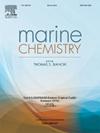Responses of the dynamics of particulate organic matter to different track typhoons in coastal waters
IF 2.5
3区 地球科学
Q2 CHEMISTRY, MULTIDISCIPLINARY
引用次数: 0
Abstract
The impact of typhoons on marine biogeochemical processes depends on their intensity, track, and speed. However, how particulate organic matter (POM) dynamics respond to typhoons with distinct tracks remains poorly understood. This study investigated physicochemical parameters and stable isotopes of POM (δ13C-POC and δ15N-PN) through continuous observations (one cruise before the typhoon and four cruises after the typhoon, with a 5-day interval) in Zhanjiang Bay following two distinct track typhoons. During Typhoon Lionrock (landfall on the left side of the bay), onshore-wind stress drove high-salinity seawater intrusion, forming a strong salinity front in the bay that suppressed phytoplankton growth (Chl-a decreased by 80 %). In contrast, Typhoon Chaba (landfall on the right side of the bay) generated offshore-wind stress that resulted in weaker water mixing, while abundant terrestrial nutrient input promoted phytoplankton growth (Chl-a increased by two times in the 2nd and 4th cruises after the typhoon). Nevertheless, positive apparent oxygen utilization (AOU) values in the water column were observed after both typhoons, indicating strong decomposition of POM in Zhanjiang Bay. The strongest decomposition (over 80 %) for the two typhoons all occurred after 3 days of the typhoon landfall, and gradually decreased after 8 days of the typhoon landfall. The POM degraded after Typhoon Lionrock mainly originated from resuspended old POM, while from fresh POM (phytoplankton) after Typhoon Chaba. Additionally, the decomposition degree (56 %) induced by Lionrock was stronger than that induced by Chaba (44 %), suggesting that the typhoon landing on the left side of the bay are not conducive to marine carbon burial.
沿海海域不同路径台风对颗粒物有机物动力学的响应
台风对海洋生物地球化学过程的影响取决于其强度、路径和速度。然而,颗粒有机物质(POM)动力学如何响应具有不同路径的台风仍然知之甚少。本文通过连续观测(台风前1次,台风后4次,间隔5 d),研究了湛江湾两次不同路径台风后POM的物理化学参数和稳定同位素(δ13C-POC和δ15N-PN)。台风“狮子石”(登陆于海湾左侧)期间,陆上风应力驱动高盐度海水入侵,在海湾形成强盐度锋,抑制浮游植物生长(Chl-a下降80%)。台风“查巴”(登陆海湾右侧)产生的近海风应力导致水体混合减弱,而丰富的陆地养分输入促进了浮游植物的生长(Chl-a在台风后的第2次和第4次巡航中增加了2倍)。但两次台风过后,湛江湾水体的表观氧利用率(AOU)均为正,表明POM在湛江湾分解强烈。两个台风的最强分解(80%以上)均发生在台风登陆3天后,8天后分解逐渐减弱。台风“狮子山”后降解的POM主要来源于重悬浮的旧POM,而台风“查巴”后降解的POM主要来源于新鲜的浮游植物。此外,“狮子岩”的分解程度(56%)比“查巴”的分解程度(44%)更强,说明登陆海湾左侧的台风不利于海洋碳埋藏。
本文章由计算机程序翻译,如有差异,请以英文原文为准。
求助全文
约1分钟内获得全文
求助全文
来源期刊

Marine Chemistry
化学-海洋学
CiteScore
6.00
自引率
3.30%
发文量
70
审稿时长
4.5 months
期刊介绍:
Marine Chemistry is an international medium for the publication of original studies and occasional reviews in the field of chemistry in the marine environment, with emphasis on the dynamic approach. The journal endeavours to cover all aspects, from chemical processes to theoretical and experimental work, and, by providing a central channel of communication, to speed the flow of information in this relatively new and rapidly expanding discipline.
 求助内容:
求助内容: 应助结果提醒方式:
应助结果提醒方式:


